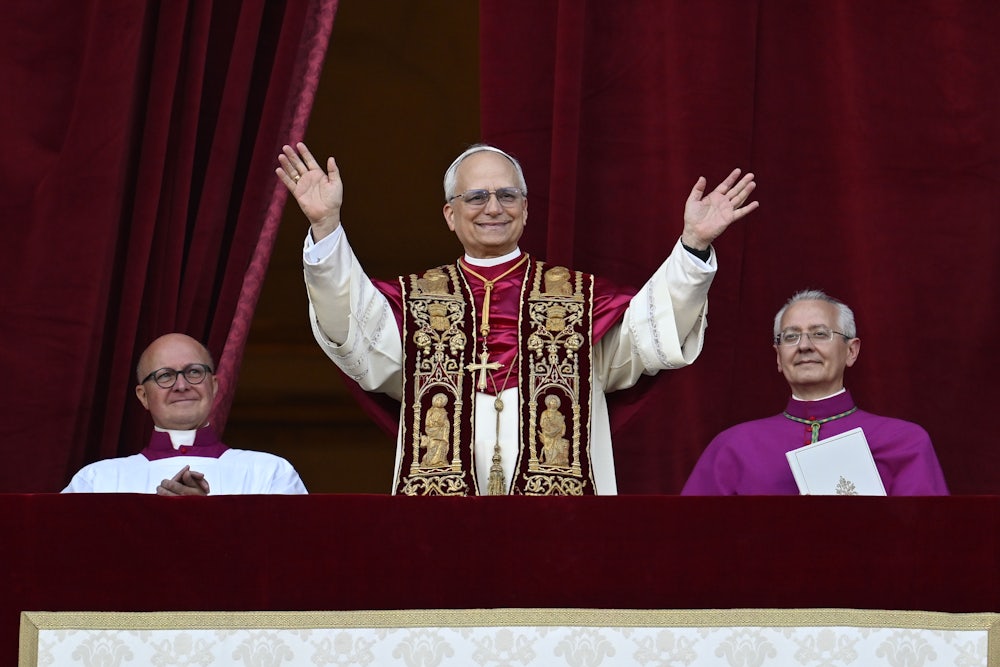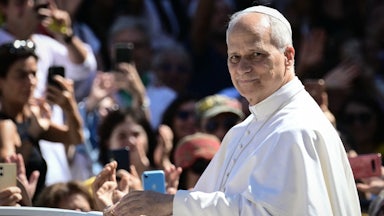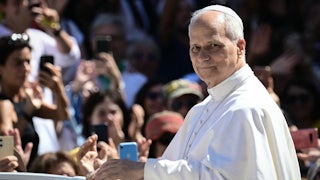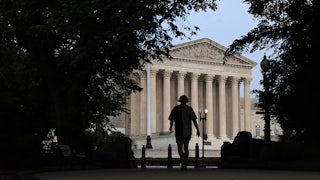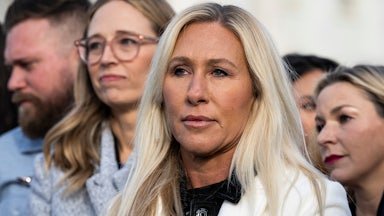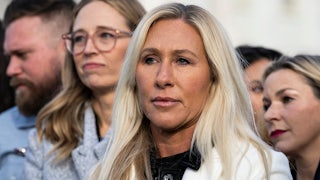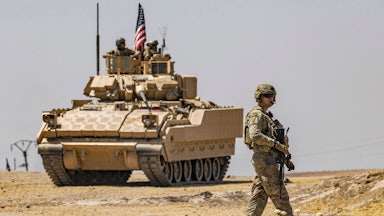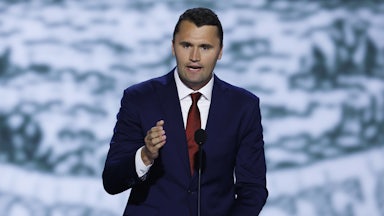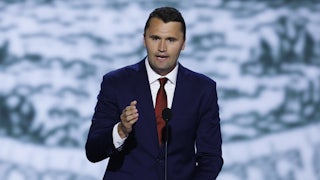I still cannot quite believe that there is an American pope. Two hundred and sixty-seven men have served as the bishop of Rome over the last two thousand years. There have been Medici popes and Borgia popes, warrior popes and scholar popes, wise ones and venal ones—and now, there is one from Chicago.
Leo XIV, formerly Robert Prevost, is now the spiritual head of roughly 1.4 billion Catholics worldwide. He is the most powerful American in history who was not elected to the White House. And while Leo was the bishop of a Peruvian diocese, not an American one, his elevation is still a triumph for American Catholics who have often been regarded with suspicion and skepticism by the church’s leadership.
For the United States itself, this is an unqualified triumph of religious pluralism. Leo XIV is the first pontiff to hail from a country that is not majority-Catholic since the emergence of the modern nation-state. The election of an American pope—and the nation’s warm reaction to it—is also a fitting coda to two centuries of anti-Catholic animus in American society.
I am also not surprised that baseball, the great pluralizer of the nation, played a role in this story. Two or three generations ago, the election of an American pope would have led to protests and perhaps even riots. In 2025, it instead led to frenzied speculation about his Chicago sports affiliations. In the initial wave of reports, some outlets made a mistake. “Whoever said Cubs on the radio got it wrong,” his brother John told an NBC Chicago reporter. “It’s Sox.”
Journalists and social media commentators knew what that meant: This is a pope who knows what suffering looks like. The Chicago White Sox is one of baseball’s oldest clubs—and among its least successful. Even their victories do not lend themselves to boasting and braggadocio. The uninspiring 1906 roster that won the Sox’s first World Series title became known as the “Hitless Wonders” for their poor batting average. They prevailed in six games only because their opponents, the cross-town rival Cubs, somehow fared even worse.
The Sox’s second title in 1917 against the New York Giants brought a little more respectability to the club. So did emerging stars like “Shoeless” Joe Jackson, who returned from service in World War I to post a .350 batting average in 1919. But their glory was soon overshadowed in popular memory by the tragedy of that year’s World Series, where a group of Sox players, underpaid by their penny-pinching owner, Charles Comiskey, conspired with gamblers to throw the series to the Cincinnati Reds.
The scheme worked, but the resulting scandal changed baseball forever. Owners responded to universal public dismay by creating a commissioner’s office to oversee both the American and National Leagues, investing it with near-dictatorial power over players, managers, and clubs. Judge Kennesaw Mountain Landis, the first high priest of the national pastime, immediately excommunicated Jackson and seven other “Black Sox” players from baseball for the rest of their lives.
Baseball has a thing about curses and championship droughts. The Red Sox kept falling short because they shipped Babe Ruth—who credited his hitting style to the Xaverian teacher who introduced him to the sport at his Catholic boys’ school—off to the rival Yankees in December 1919. The Cubs went 108 years without a championship because, it was said, of some dustup involving a local tavern owner and his goat. For the White Sox, however, the “curse” seemed to come not from some disaffected former player or disgruntled local figure but from their own team’s sins against baseball itself.
So it was perhaps fitting that the future pope was there on October 22 when the White Sox won the first game of the 2005 World Series, eventually sweeping the Houston Astros in four games. It was not the greatest curse broken this century: The Red Sox’s 2004 victory was even more stunning, and the Cubs’ 2016 championship even more historic. But it was just as cathartic, giving the long-suffering franchise something to venerate whenever the team struggled and ownership, as always, refused to spend. (Good luck moving the team to Nashville now, Jerry Reinsdorf.)
As a native son of Chicago’s South Side, Leo was undoubtedly familiar with the inequalities that Catholic social teachings oppose. Baseball could only have sharpened that awareness. No other American sport reflects the contradictions and fissures of modern life: the perpetual struggle between hard-won merit and unequal wealth, the brow-sweat of labor and the idle vanity of ownership; the national pastime that excluded part of the nation for decades.
It is often described as a game of failure, where the best batters often fail to reach first base and the best pitchers rarely throw shutouts. It holds a sacred status in American life that endures despite the many sins of its past: gambling and bigotry, cheating and theft. Augustine of Hippo would have probably loved it. What could be more appropriate for and representative of, he might say, this fallen, failed world?
Perhaps that is why when popes come to the United States to hold large open-air masses, they tend to borrow our cathedrals. Paul VI, the first pontiff to visit America, celebrated Mass with 100,000 attendees at Yankee Stadium, baseball’s de facto national basilica, in 1965. The Archdiocese of New York even paid rent to avoid a church-state separation issue with its use of the stadium. (Like Old St. Peter’s, the House that Ruth Built was later razed to make way for its current, more grandiose replacement, which hosted Benedict XVI in 2008.)
When John Paul II came to Los Angeles in 1987, he celebrated Mass at two separate stadiums. At the Los Angeles Memorial Coliseum it was reportedly a grim, troubled affair. Football gridirons are centers of strife and dominance; a Hail Mary pass is typically the only instance of piety during a game. One hundred thousand ticket-holders waited in hours-long lines to gain entry. People collapsed from stress and heat exhaustion, and fights reportedly came close to breaking out.
But Dodger Stadium had a more euphoric atmosphere where, as the Los Angeles Times reported, the spirit was “not deference but joy.” The ballpark had already been nicknamed “Blue Heaven on Earth” by Tommy Lasorda, the team’s voluble longtime manager and a devout Catholic who had priests celebrate Mass on-site for players before Sunday games. The name stuck for aesthetic reasons but is also fitting for theological ones. Baseball, more than anything else, is about going home.
The United States has always been home to Catholics, but it has not always been friendly to them. Many colonial Americans inherited the prejudices of their early modern English forebears, who associated the Catholic faith with religious strife, foreign subversion, and continental adversaries like France and Spain. Stuart-era reforms to the Church of England, for example, prompted thousands of English Puritans to resettle in the Massachusetts Bay Colony.
By the time of the revolution, American leaders had embraced religious freedom and church-state separation as an antidote to the religious conflicts that had riven Europe for the previous two centuries. Though the new nation was largely Protestant, early presidents treated Catholics with respect. “I presume that your fellow-citizens will not forget the patriotic part which you took in the accomplishment of their revolution, and the establishment of their government,” George Washington wrote to American Catholics in 1790, “or the important assistance which they received from a nation in which the Roman Catholic faith is professed.”
But the nineteenth century proved that anti-Catholicism could still be a potent political force in American life. It fueled the Know-Nothings of the 1840s and 1850s, who claimed that new immigrants would be more faithful to Rome than to the Constitution, subverting and supplanting the existing Protestant majority. It influenced Republicans in the 1870s and 1880s who opposed parochial schools, where American children would supposedly be taught an alien and un-American ethos.
The Catholic Church had its own skepticism of the U.S. as well. The revolutions and radical movements of nineteenth-century Europe put the church’s leaders on a conservative, defensive footing—sometimes literally, as when Italian nationalists invaded and annexed the Papal States in 1870. Modernism, liberalism, and secularism were denounced as adversaries to the church’s teachings and its privileged place in countries like France, Italy, and many of the smaller states that would become Germany.
Pope Leo XIII, the current pontiff’s namesake, praised Americans’ “well-ordered republic” in a 1895 letter to the U.S. bishops for allowing Catholics to “live and act without hindrance.” At the same time, he warned it would be “very erroneous to draw the conclusion” that American civil secularism was “the most desirable status of the Church, or that it would be universally lawful or expedient for State and Church to be, as in America, dissevered and divorced.” European bishops, in other words, better not get any funny ideas from the New World.
That skepticism, for lack of a better word, manifested itself in the church’s approach to its American brethren. American Catholics were often perceived to be more liberal, more open-minded, and more questioning than their overseas counterparts. The common belief among Vaticanologists, at least until two weeks ago, was that an American would never become pope because cardinals from other countries thought that the U.S. already held too much power on the world stage.
Anti-Catholicism peaked in America in the 1920s, when the second iteration of the Ku Klux Klan marched in public without fear and Al Smith, the first Catholic major-party presidential candidate, lost the 1928 election amid smears that he would make Washington subordinate to Rome. The Vatican reconciled itself with the U.S. more formally in the 1930s as the world war neared, but signs of the old arm’s-length treatment remained. There would not be an American ambassador to the Holy See, for example, until 1984.
Political, social, and religious realignments in this country have since made organized and overt anti-Catholicism untenable. Christianity’s various denominations now believe that they have more in common with each other than with secularism, as shown by the rise of the religious right in the 1980s. For the first half of this decade, there was simultaneously a Catholic president, a Catholic speaker of the House, and a Catholic majority on the Supreme Court. Few noticed, and no one really cared. The Constitution endured.
Leo’s approach to theological and pastoral questions—on engaging with LGBTQ and divorced Catholics, on synodality and the role of women and the laity in the church, on far-right leaders like Donald Trump and extreme concentrations of wealth—will emerge more fully with time. For now, the nation is content to speculate about the pope’s views on the designated hitter and the infield-fly rule. In a time when the American constitutional order is under constant threat, the demise of an ancient prejudice—and a victory for American pluralism—is worth celebrating.
